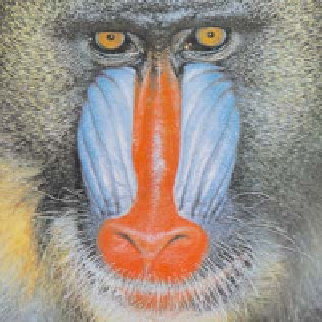Image Processing Reference
In-Depth Information
Fig. 10.20. Image enhancement by reinforcing linear symmetry tensor directions, after [224]
number of filters determines how coarsely the Fourier spectrum is down-sampled.
The more filters there are in the filter ensemble, the more the Gabor filter responses
will approach an ordinary Fourier spectrum while the size of the neighborhood being
analyzed will approach the size of the original image. Figure 10.21 shows a Gabor
filter set which is (polar) separable in tuning directions and absolute frequencies. The
tuning frequencies of the filters (marked with
) along with the isoamplitude curves
of the filters are given in the graph. For real images, half of the filters are not needed
e.g., those drawn in cyan, because the response of a filter equals the complex conju-
gate of the response of the filter at the mirror site through the origin. Increasing the
number of filters in the Gabor filter bank amounts to increasing the sampling resolu-
tion of the Fourier spectrum, since the filter bandwidths decrease when the frequency
resolution increases.
A linearly symmetric (local) image has a power spectrum that is concentrated
to a line. Depending on the direction of the image and the spectrum discretization,
this line may or may not pass exactly through the tune-on frequencies, the frequency
grid points, e.g., see the two drawn axes in Fig. 10.21. In the case when this axis
has the same direction as the direction of one or more frequency grid points (Gabor
filters), then the responses of these filters will account for a significant share of the
total response power stemming from the filter ensemble. In Fig. 10.22, the Fourier
transform of such an image is shown as the dashed energy concentration passing ex-
actly through a subset of filter tuning sites. The filter tuning sites are marked with
×
×
in the figure. The magnitudes of the filter responses are modulated by the sizes of
the circles placed at the corresponding frequency grid points. The responses repre-
sented by cyan circles can be deduced from their mirrored counterparts as mentioned
before.
To determine the dominant direction of a local image, one could identify the Ga-
bor filter yielding the largest magnitude and then use the tune-on direction of the
filter as the direction searched for. However, the disadvantage of this approach is



